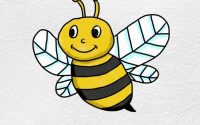Grey Wolf Drawings Easy Face Drawing Guide
Understanding Basic Wolf Anatomy for Simplified Drawings
Grey wolf drawings easy face drawing – Drawing a wolf’s face, even a simplified one, requires understanding its basic anatomy. This will help you capture its essence and create a believable image, even with minimal detail. We’ll focus on key features and simplification techniques to make your wolf drawings easier and more effective.
Simplifying a wolf’s face for a drawing means focusing on the essential shapes and proportions that define its features. By understanding these core elements, you can create a recognizable wolf face with fewer strokes and less detail.
Simplified Muzzle Structure, Grey wolf drawings easy face drawing
The wolf’s muzzle is arguably the most distinctive part of its face. Instead of drawing every muscle and curve, we can simplify it into basic shapes. Imagine the muzzle as a slightly elongated wedge, tapering from the wide base near the eyes to a narrower point at the nose. The top of the muzzle forms a gentle curve, while the bottom line is more straight.
Add a small, rounded nose at the tip. Avoid overly detailed nostrils.
Simplified Eye Structure
A wolf’s eyes are almond-shaped, slightly slanted, and relatively small compared to its overall head size. For simplification, draw them as elongated ovals, with a subtle curve at the top and bottom. Add a small, dark circle for the pupil, placed slightly off-center. A small highlight can be added to suggest shine and depth. Don’t worry about detailed irises or complex reflections – keep it simple.
Simplified Ear Structure
A wolf’s ears are pointed and erect, typically triangular in shape. For simplification, draw them as two slightly curved triangles, pointing upwards and slightly back. The base of the ear should be relatively wide, gradually tapering to a sharp point. Avoid excessive detail within the ear itself. A simple Artikel is sufficient to capture the essence of the shape.
Examples of Simplified Wolf Face Drawings
Imagine a drawing where the muzzle is a simplified wedge shape, the eyes are simple almond shapes with a dark pupil and a small highlight, and the ears are represented by two slightly curved triangles. This minimal approach still clearly communicates the essence of a wolf’s face. Another example might show a slightly more rounded muzzle, reflecting a younger wolf, while maintaining the simplified eye and ear shapes.
The key is to capture the overall form and proportion, not every minute detail. Even a line drawing can effectively capture the wolf’s features with careful attention to the simplified shapes.
Exploring Different Drawing Styles for Easy Grey Wolf Faces: Grey Wolf Drawings Easy Face Drawing
Drawing a wolf face can be a fun and rewarding experience, regardless of your skill level. The key is choosing a drawing style that suits your abilities and desired outcome. Let’s explore three distinct approaches: cartoonish, realistic, and stylized. Each offers unique advantages and challenges for beginners.
Cartoonish Grey Wolf Face Drawing
A cartoonish style simplifies the wolf’s features, exaggerating certain aspects for a playful and expressive look. Think big, round eyes, a simplified snout, and perhaps floppy ears. The focus is on conveying emotion and personality rather than anatomical accuracy. Imagine a wolf face with oversized, bright eyes that sparkle with mischief. The snout is short and rounded, almost like a button nose.
The ears are large and slightly droopy, giving it a friendly, approachable look. The fur is suggested with simple lines, not detailed shading. The overall effect is cute and appealing, ideal for children’s books or cartoons.Advantages: This style is forgiving of inaccuracies and requires minimal detail, making it perfect for beginners. The simplified shapes are easy to master, allowing for quick sketching and experimentation.Disadvantages: Lack of anatomical detail may result in a less realistic representation.
It might be challenging to capture the wolf’s inherent wildness and power.
Realistic Grey Wolf Face Drawing
A realistic drawing aims for anatomical accuracy, capturing the wolf’s musculature, fur texture, and facial features with precision. This style requires a good understanding of wolf anatomy and shading techniques.Envision a wolf face rendered with meticulous detail. The fur is depicted with individual strands, creating a sense of texture and depth. The muscles of the jaw and cheeks are subtly suggested through shading, giving the face a three-dimensional quality.
The eyes are intensely expressive, conveying intelligence and alertness. The overall impression is one of power and realism.Advantages: A successful realistic drawing is incredibly rewarding and showcases a high level of skill. It allows for a detailed and accurate portrayal of the animal.Disadvantages: This style requires significant practice and skill in observation and rendering. Beginners may find it challenging to achieve the level of detail and accuracy required.
It also takes considerably longer to complete.
Stylized Grey Wolf Face Drawing
A stylized approach combines elements of realism and abstraction. It simplifies certain features while retaining key characteristics that define the wolf. This style allows for creative freedom and personal interpretation.Picture a wolf face with simplified shapes and bold lines. The fur texture might be suggested through cross-hatching or other textural techniques, but without the level of detail found in a realistic drawing.
The eyes could be more expressive and stylized, perhaps elongated or almond-shaped. The overall effect is sleek, elegant, and memorable.Advantages: This style offers a balance between realism and creative expression. It allows for experimentation with different shapes, lines, and textures, while still conveying the essence of a wolf. It is less technically demanding than realism.Disadvantages: Finding the right balance between simplification and recognizability can be tricky.
Right, so you’re into drawing easy wolf faces, innit? Loads of vids on YouTube for that, dead simple. But if you fancy a bit of a different challenge, check out this tutorial on 9/11 towers drawing easy , it’s proper detailed. Then, after that, you can get back to your wolfy drawings – maybe try a grumpy one this time?
Too much simplification might result in a drawing that is not easily identifiable as a wolf.
Presenting Examples in a Table Format
Illustrating various approaches to drawing simple grey wolf faces helps solidify understanding and inspires creativity. This table provides five examples, each showcasing a different stylistic approach to achieve an easy-to-draw yet expressive wolf face. The descriptions highlight key characteristics of each style, emphasizing simplicity and accessibility for beginners.
Easy Grey Wolf Face Drawing Styles
| Drawing Style | Description | Key Features | Simplified Elements |
|---|---|---|---|
| Simplified Geometric Shapes | Uses basic shapes like circles, triangles, and semi-circles to construct the wolf’s face. | Emphasis on form over detail; minimal lines. | Eyes are simple circles; nose is a triangle; muzzle is a rounded rectangle. |
| Cartoonish Style | Exaggerates features for a playful, less realistic look. | Large, expressive eyes; simplified fur; rounded shapes. | Minimal shading; bold Artikels; simplified ear shapes. |
| Line Art | Focuses on Artikels and lines to create the wolf’s form. | Uses varying line weights for emphasis; minimal shading or detail. | Simple shapes for the eyes, nose, and mouth; clean lines. |
| Impressionistic Style | Suggests the wolf’s features rather than precisely defining them. | Loose brushstrokes; focus on light and shadow; minimal detail. | Simplified shapes and color blocks; less emphasis on precise lines. |
| Minimalist Style | Uses the fewest possible lines and shapes to represent the wolf’s face. | High contrast; bold lines; lack of detail. | Eyes are represented by simple dots; nose is a small triangle; muzzle is a single line. |
Illustrating Fur Texture and Shading Techniques
Bringing your grey wolf drawing to life involves mastering fur texture and shading. These techniques add realism and depth, transforming a simple sketch into a captivating piece. Even with simplified anatomy, you can achieve a surprisingly realistic look by focusing on these key aspects.Successfully depicting fur texture on a simplified grey wolf face doesn’t require intricate detail. Instead, it focuses on suggesting the direction and density of the fur using a variety of shading and line techniques.
This approach allows for a balance between simplicity and realism, perfect for easy drawings.
Methods for Depicting Fur Texture
Several methods can effectively suggest fur texture without overwhelming detail. Short, light strokes can mimic the short, dense fur on a wolf’s face, while longer, more varied strokes can represent longer fur around the muzzle or ears. Varying the pressure of your pencil also creates texture – lighter pressure for finer fur, heavier pressure for thicker areas. Experimentation is key to finding what works best for your style.
Shading Techniques for Depth and Volume
Shading is crucial for creating a three-dimensional effect. Observe how light falls on a wolf’s face; identify the light source and then shade accordingly. Use darker tones in the recesses of the face, such as under the eyes and around the muzzle, to create shadows and depth. Gradually lighten the tones as you move towards the areas directly hit by light.
This subtle shift in tone creates volume and form.
Achieving Realistic Fur Effect with Minimal Detail
The key to a realistic fur effect lies in understanding the direction of fur growth. On a wolf’s face, the fur generally flows downwards. Reflect this direction in your strokes, using short, light lines that follow this natural flow. Avoid perfectly uniform shading; instead, add subtle variations in tone and density to simulate the natural unevenness of fur.
This creates a much more lifelike appearance. Consider using a blending stump or your finger to soften harsh lines and create a smoother transition between light and shadow. This will help to create a more cohesive and natural-looking fur texture.
FAQ Explained
What are the best pencils for drawing grey wolf faces?
HB, 2B, and 4B pencils offer a good range for varying levels of shading and detail. Experiment to find your preference.
How can I improve the realism of my wolf drawings?
Focus on accurate anatomy, detailed shading, and the subtle variations in fur texture. Study reference photos closely.
What if I don’t have artistic experience?
This guide is designed for beginners. Start with the basic shapes and gradually build complexity as your confidence grows.
Are there any online resources to supplement this guide?
Many online tutorials and reference images are available. Search for “grey wolf anatomy” or “animal drawing tutorials” for additional resources.



